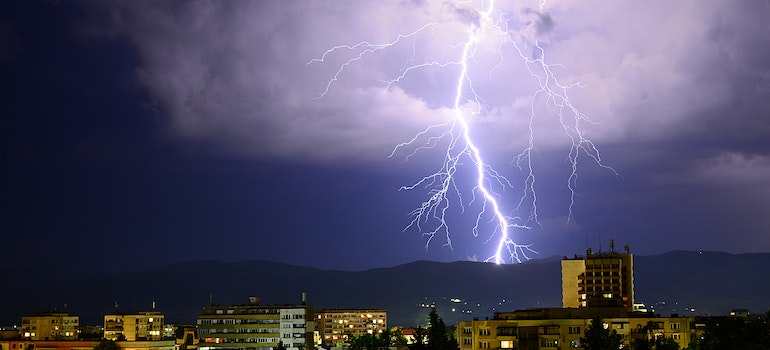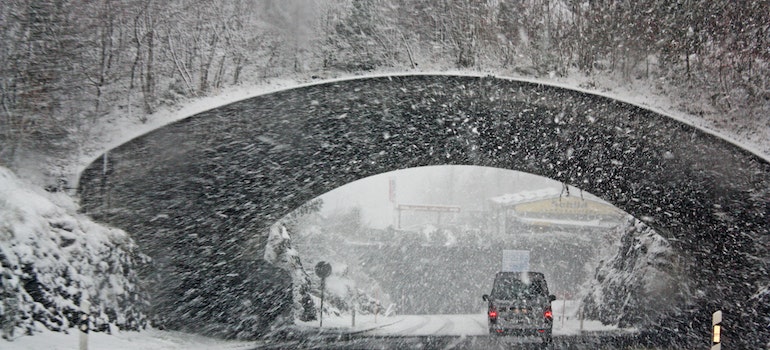How to Move In Bad Weather?
Nobody likes the rain or storms. Sure, they are fun, but only in the warmth and comfort of your home. This is why we are sure that if you planning a move in bad weather, you probably feel irritated or worried. However, with proper planning and preparedness, you can ensure a smooth transition to your new home. This article provides expert guidance and practical tips by Best Cross Country Movers to help you navigate the obstacles and make your move a success, even in adverse weather conditions.
Safety first – assessing risks and conditions
When facing a move in challenging weather conditions, your safety should be the utmost priority. To ensure a smooth and secure transition, it is essential to assess the risks and conditions associated with the specific weather you are facing. By evaluating potential hazards, you can make informed decisions and take appropriate measures to protect yourself, your belongings, and the moving team.

Begin by considering the type of weather you are dealing with, whether it’s heavy rain, snowfall, or strong winds. Identify the potential risks associated with these conditions, such as slippery surfaces, reduced visibility, or the risk of items getting damaged. Take into account the severity of the weather and the duration of the forecasted conditions. If you are moving to cities like Anchorage with extremely low temperatures, icy roads, and snow, you should reach out to your cross country movers in Anchorage to make sure it’s safe to move. Don’t be hesitant to reschedule your move if the weather conditions are too extreme.
Evaluate the condition of your current and new locations, including the pathways, driveways, and entryways. Assess if they are adequately prepared for the weather. Look for potential obstacles, such as ice patches or fallen branches, that could pose a safety risk during the move. If you’re moving to a city like Fargo with many buildings, make sure you have the necessary permits that will allow cross country movers in Fargo to park their trucks and start unloading your items. Based on your assessment, make an informed decision on whether it is safe to proceed with the move or if rescheduling is necessary. In some cases, it may be prudent to delay the move to ensure the safety of everyone involved.
Shielding your belongings from the storm and clearing the way to your new home
When moving in bad weather, it’s crucial to protect your belongings from potential damage. Use waterproof packing materials, such as plastic covers or boxes, to shield your items from rain or snow. Wrap delicate belongings in bubble wrap or blankets for added protection during transit. Consider utilizing climate-controlled storage or containers for temperature-sensitive items to ensure their integrity throughout the move.

Creating clear and safe pathways is essential for a successful move in bad weather. Prioritize clearing snow, ice, or debris from driveways, walkways, and entrances to prevent accidents. Take proactive measures by using salt, sand, or ice melt products to enhance traction and avoid slips and falls. Additionally, fashion temporary coverings, such as tarps or plastic sheets, to shield entryways from rain or snow, keeping your home clean and dry during the moving process. Even if your area doesn’t have much, or any, snow, which is the case for people who are living in, for example, Texas, you should still follow these guidelines when moving with long distance movers in Austin. After all, it’s better to be safe than sorry.
Utilizing professional moving services
When it comes to moving in challenging weather conditions, enlisting the help of professional moving services can make all the difference. These experts are equipped with the necessary knowledge, experience, and equipment to navigate the weather battle successfully. They’ll handle the logistics while you focus on other essential aspects of your move. Movers in areas where frequent bad weather happens like cross country movers Orlando have all the experience and expertise you will need to move in bad weather. With their help, it is possible to have a successful relocation during storms.
Gear up for the weather battle – essential supplies and equipment
The definition of bad weather varies from state to state. If you are moving in Anchorage Alaska, bad weather means icy roads and too big a danger to move. However, in Edmond Oklahoma, that means a lot of rain. Since you can’t always plan for bad weather when moving, the best thing you can do is to make sure your cross country movers Edmond have the necessary equipment and supplies to move your belongings carefully. That should include having enclosed, weatherproof trucks for your belonging, and tarps to cover the entryways or driveway. Lastly, reusable plastic boxes for moving will really come in handy in bad weather conditions. Cardboard is easy to dissolve but plastic is weather proof. But keeping your belongings safe is one part of the equation. YOu should also pack supplies and equipment such as an emergency kit with flashlights, batteries, first aid supplies, and medications.
Driving and road safety needs special attention when dealing with a move in bad weather
When faced with challenging weather conditions during your move, prioritizing driving and road safety is paramount. First and foremost, reduce your speed and maintain a safe following distance to accommodate longer stopping distances on slippery roads. Additionally, use caution when braking to avoid skidding. Regularly check your vehicle’s tires, ensuring they have sufficient tread depth and proper inflation to optimize traction. This will enhance your vehicle’s stability in winter driving and grip on wet or icy surfaces.

Furthermore, keep your headlights on to improve visibility for both yourself and other drivers. It’s also advisable to use your low-beam headlights in foggy conditions to minimize glare and enhance your visibility. Be mindful of potential hazards such as standing water, icy patches, or fallen debris on the road. Adjust your driving accordingly, using gentle and gradual maneuvers to prevent sudden skidding or loss of control. Lastly, stay updated on weather and road conditions by monitoring local news or traffic reports.
Embrace the unexpected weather surprises
As you embark on your move in bad weather, armed with the knowledge and strategies from this guide, you’re well-prepared to tackle any weather challenge that comes your way. Remember, safety and preparation are key. Stay informed, protect your belongings, and maintain open communication with your moving team. By embracing flexibility and maintaining a positive attitude, you’ll overcome any weather obstacle and make your move a success. With the right mindset and a little bit of fun, your rainy or snowy move can turn into an adventure you’ll remember for years to come.

